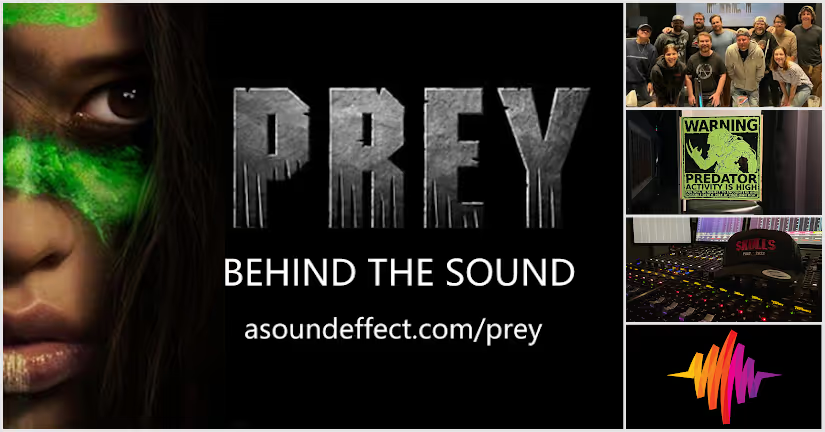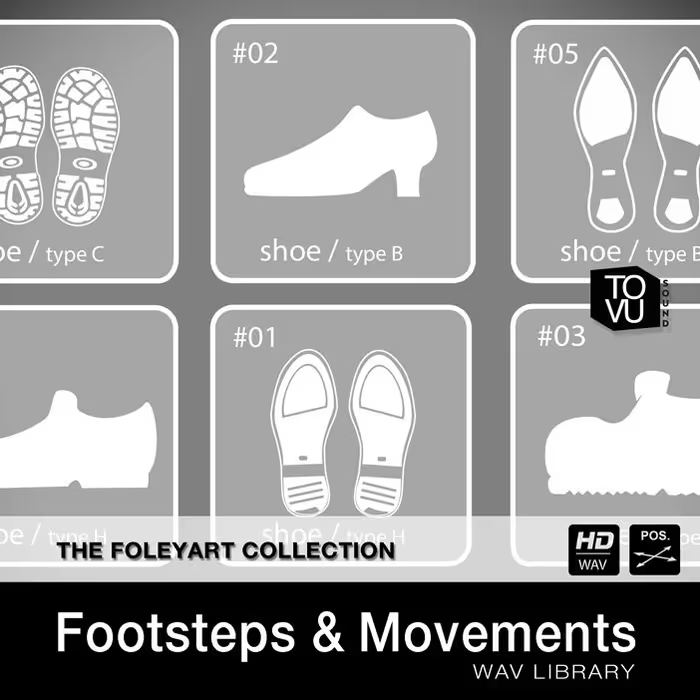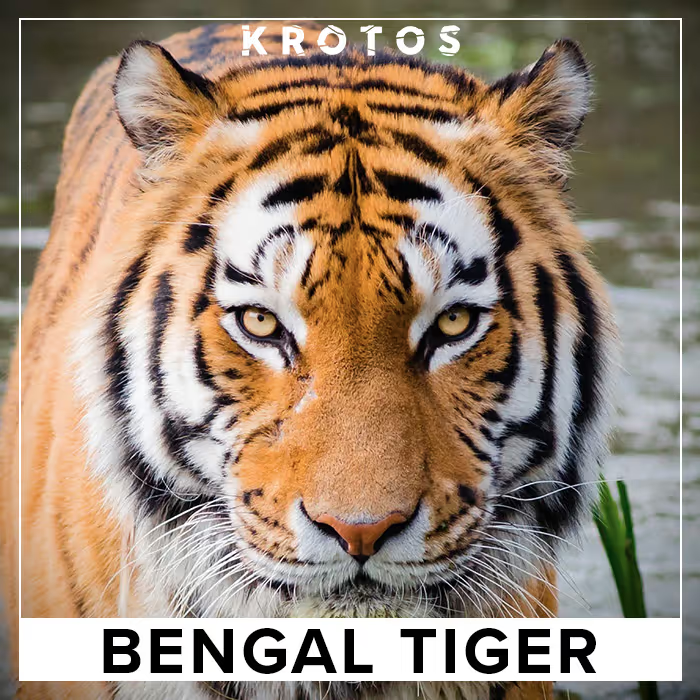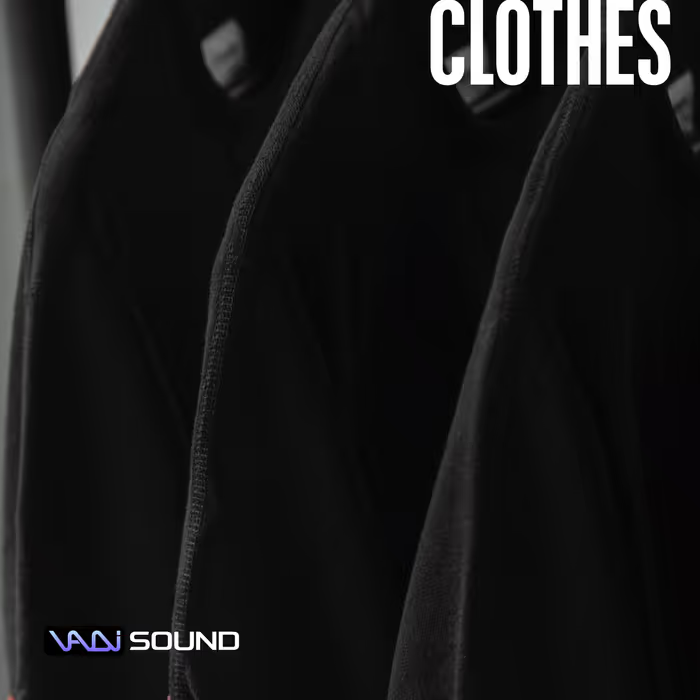In turn, the Predator in Prey faces off with humans who are also less technologically advanced – a tribe of Comanche with stone and wood weapons and a roaming pack of French fur traders, who have black powder muskets and pistols.
Here, Terhune talks about redesigning iconic Predator sounds to fit the more primitive time, Dialogue/ADR Supervisor Jessie Anne Spence discusses the unique opportunity to record and edit Comanche dialogue and group, and re-recording mixer Craig Henighan (who co-mixed with Terhune) talks about finding the emotion for the mix in Dolby Atmos.
As humans, we’re programmed to mimic sounds (as well as facial expressions and hand gestures) from birth. That’s the start of language for us as babies. So it’s no wonder that mimicking sounds still fascinates us as adults. Who hasn’t tried to reproduce the Chewbacca yell? Or haven’t done their best Homer “Doh!” when frustrated by life?
One sound that has always eluded me personally is the Predator “clicking” sound. All my shameful attempts end up sounding like cat purrs. But supervising sound editor Chris Terhune has shed new light on the proper technique for mastering the Predator clicks (which he shares in the Q&A below!!). This allowed him to perform new clicks for director Dan Trachtenberg’s Predator prequel Prey (now streaming on Hulu).
He also got to update legacy sounds and create new sounds for the Predator’s weapons and tech, helping them to feel less advanced since the film is set in 1719.
He’s joined by Dialogue/ADR Supervisor Jessie Anne Spence, who talks about recording and editing Comanche dialogue and loop group, and by the Emmy Award-winning Craig Henighan, who mixed dialogue and music on Prey alongside Terhune who also mixed the effects on the film.
Here, they talk about building very specific backgrounds, paring back the mix to bring out the emotion, cutting and mixing crisp action sequences, and so much more!
Prey | Official Trailer | Hulu
The backgrounds in Prey seem so specific and reactive. For instance, Naru is throwing an axe in the beginning, and the forest is so quiet. Then on her last big throw, a flock of birds takes off in the distance as if they’re startled by the sound. What were director Dan Trachtenberg’s thoughts on the sound of this world?
Chris Terhune (CT): For this film, to create a sense of life that didn’t feel stagnant, the backgrounds needed to have constant movement and be reactive to the characters in the story. But Dan also wanted to make sure it was specific and sparse. You could have beds of birds and trees but then you wouldn’t feel all the little details, like bugs and insects flying by the screen.
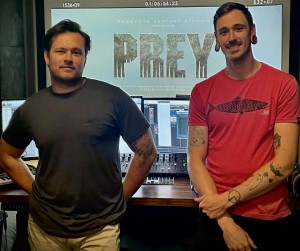
All those little sounds made you feel closer to Naru and the characters. We got really specific with the insects that we see and the grass and trees reacting to the winds. Instead of beds of birds, we wanted to pick specific birds with timing, so we could use them to create the space with echo and delay to feel the geography of the forest.
We knew the music was going to do its thing too, so Dan wanted to make sure that the environments weren’t just there to be there, but that they also had a mood to them. So everything was super intentional and Dan knew how to take each scene and make sure that the backgrounds and the music all complimented that idea of feeling a specific emotion.
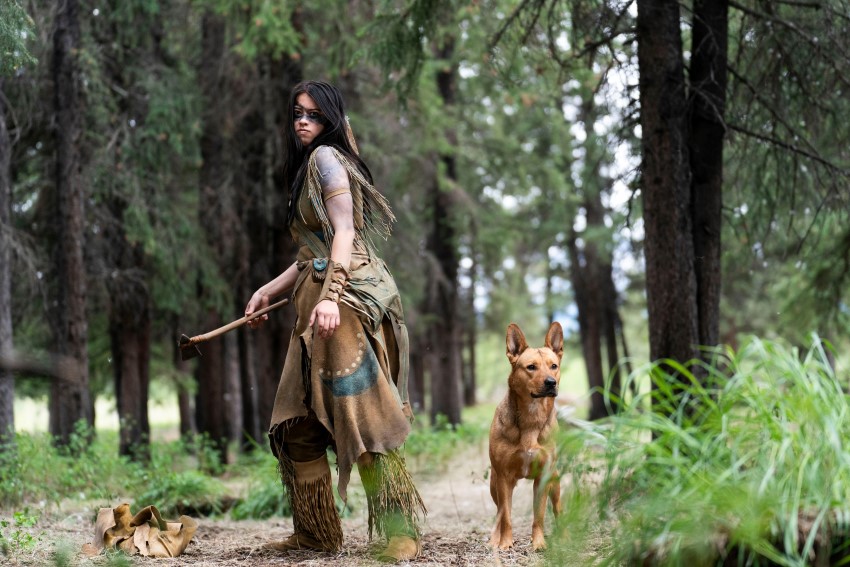
After watching the film a second time, I felt that the backgrounds helped to pull you into Naru’s hunter-mode. It’s like she’s filtering out all the unnecessary sounds in the world and just picking up on the ones that are important to her survival, or that give her information about what’s happening around her…
CT: Yeah, we thought a lot about getting the audience into her perspective by shifting the backgrounds in and out of focus to heighten her senses. It was subtle but pretty effective.
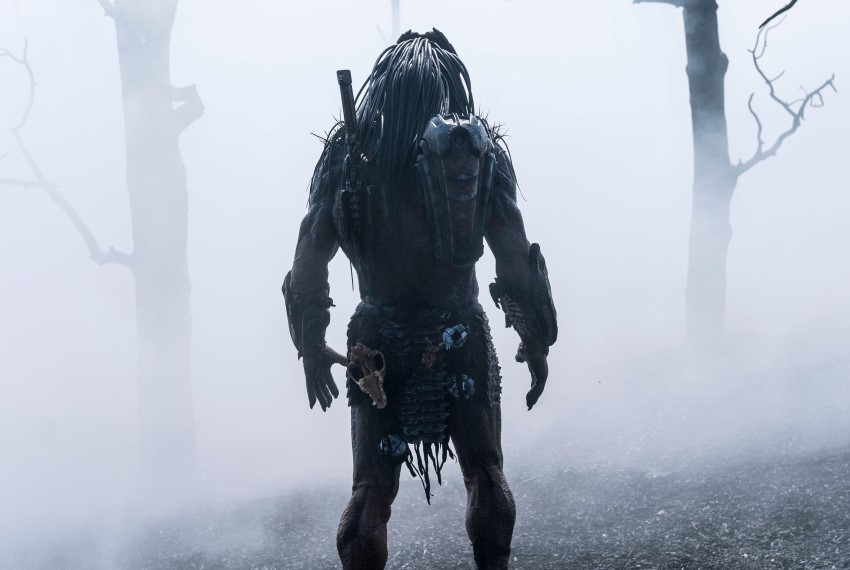
What went into the sounds of the Predator? Did you remake his iconic sounds?
CT: When we started working on this, I realized one of the first things I was going to have to do was take on the Predator click. People don’t really know that the original sound was from a voice actor. But this is a new Predator and we wanted to approach it in our own way, but still keep it iconic. So, for a few days, I would just put my phone by my face and record myself trying to figure it out.
I found a technique where you have to put the right amount of air on that little punching bag in the back of your throat (the uvula) to get it to vibrate. It’s not a sound that comes from inside the mouth; it comes from the throat and a little air comes out. It’s a whole thing.
So I finally got a version of it on my phone and I got super stoked. I sent it to our sound designer, Jimmy [James Miller], and he started mocking up some sounds. He got it pretty close. Then we spent an hour or two in my room with some mics. I just laid on the floor trying to replicate that.
PREY Behind The Sound – Initial Predator Sound Attempt
I finally got it, and so he used some of that. We also used recordings of this super clicky and creaky door in my house. My girlfriend calls it the “Preda-door.” We ended up layering that with my throat clicks and various transient designers and we had it.
PREY Behind The Sound – The Final Predator Clicking Sound
We did an A/B comparison against the original and it felt very similar, but it had more fidelity. We made a bunch of different versions of it so we could take it and modify it and even throw it through dopplers and weave it in and out of different creature and animal sounds. And that gave us more control as opposed to using the original sounds.
We did an A/B comparison against the original and it felt very similar, but it had more fidelity.
Since this Predator doesn’t have a full-faced bio-mask, Dan [Trachtenberg, director] wanted to hear the sound of its mandibles and the physicality of his throat movement. Foley helped a lot with those sounds. They did a ton for this movie. They made everything feel real and tangible. Big shout out to Alchemy Post over in New York.
There are a lot of shots of when the Predator roars and you see down his throat. So we used numerous sea lion recordings that have that hollow, bellowing sound. And I performed a lot of screaming and imitations of a sea lion roar. Most of the screams were based on how his mouth and throat were moving.
Also, we had Dan record his daughter so we could add it to the village at the beginning where kids are playing in the background. We always try to get everyone’s personal life into the movie. For example, Angela [M. Catanzaro, film editor]’s horses are part of the Predator sound, when he gets injured or when we needed a quick angry chuff. It worked so well!
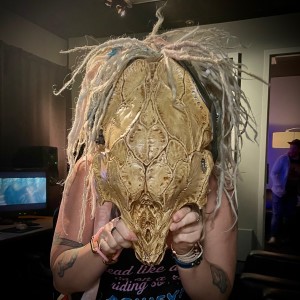
So Dan recorded his kid on his phone, just laughing and playing around. We brought this super-long take into a session and by chance, a part of the recording landed perfectly in sync with the Predator’s roar. It’s Dan’s kid just screaming her lungs out and it synced so perfectly, so we cut the rest of the recording out and kept that piece. When Dan came back to the stage, we played that scene down and we muted the designed roar and played just his daughter screaming. He didn’t expect it, and it was one of the funniest moments during the mix. But it worked so well, so we topped our designed roar with his kid screaming. It’s in one of the last roars in the final battle, and you can hear it pretty clearly.
Jessie Anne Spence (JS): The best part is that his daughter is this cute little girl. She would come on our Zoom calls occasionally and she’s just the sweetest little thing. And there’s this “Predator” roar coming out of her mouth! It’s crazy.
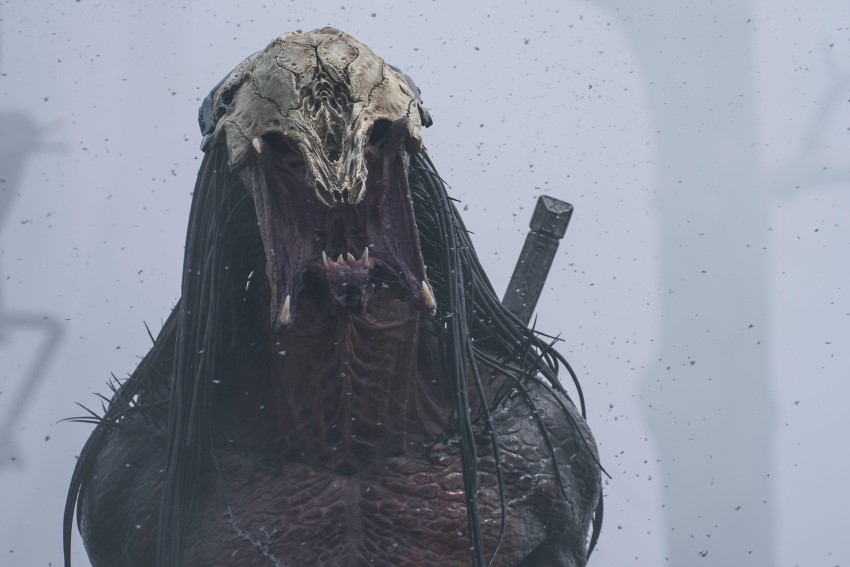
What about the Predator’s tech and weapons? There’s definitely an existing base of sounds for his tech throughout the franchise history. Did the director want to reuse or remake those sounds, or take a new approach since this is a prequel and the tech isn’t as advanced?
CT: When you work on a franchise like this one, you want to stick to a familiar palette so we tried to weave in some legacy sounds that make you feel like, “Oh yeah, I know this world.”
But even though the Predator is far more technologically advanced than the humans in 1719, we still wanted him to feel primitive compared to the Predators we’ve seen in our current era. So instead of a shoulder cannon, he has his own type of arrow system that’s laser guided. So he’s still advanced but it didn’t feel overpowering to that world.
…we still wanted him to feel primitive compared to the Predators we’ve seen in our current era.
The Comanche didn’t have any kind of metal; So we wanted to make sure that all their weaponry was stone or wood, but then the Predator had metal. So you can really feel the difference between their technology.
For the Predator, we tried to make crazy thick, otherworldly-sounding metals, using magnets, pneumatic air pressure, dry ice on big metal surfaces, and different gym equipment bars that had great tones and ring-outs.
Using dry ice for PREY weapon sound effects
What also made him feel not as far advanced with his technology was his cloaking system. His cloaking system worked, but it would glitch out when it interacted with the world around him and I thought that was a nice touch.
PREY Behind The Sound – Predator Cloaking Clicking Sounds
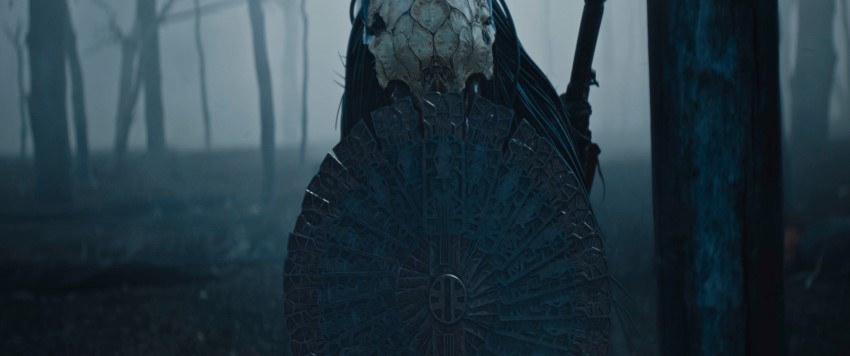
Did you have a favorite Predator weapon sound that you created? Which one was the most fun to make?
CT: Probably the laser arrows. We had the challenge from Dan to create a beeping tracking system. So after the Predator fires the bolt arrow, it cuts away to another character or shot, but we want to feel that the arrow is still tracking around the environment. So we got to use those beeps and play with the space on where that arrow was tracking before it impacts its target.
That was a lot of fun to do during the mix.
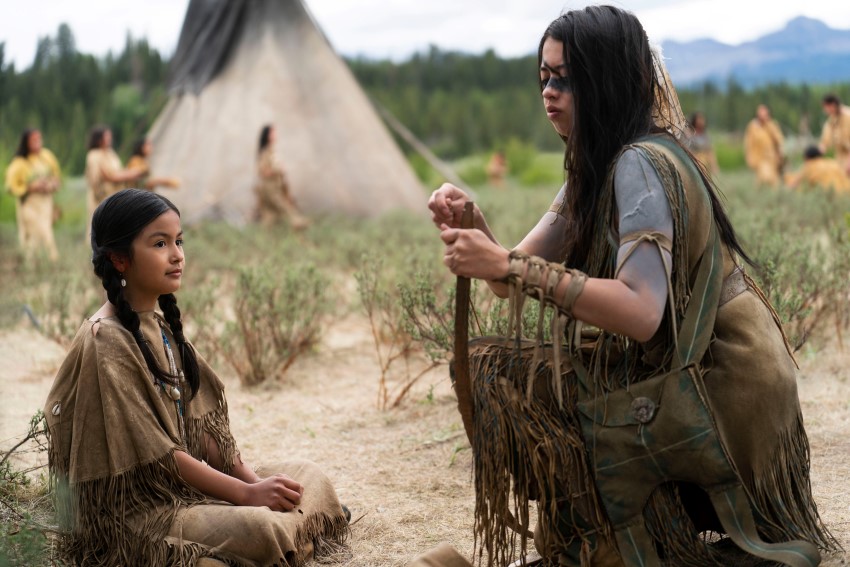
As Naru returns to her village, she hears a commotion that a lion has taken Puhi. The loop group/walla is in Comanche, as is the walla for when Taabe returns with the lion, and at several other moments in the film. Can you talk about recording and cutting the Comanche walla?
JS: This was an interesting process for me because I’ve never been submerged in such a deep end of language and culture.
At first, we weren’t sure if we were going to be doing the loop/walla in English or Comanche, so we did both. The process on the day was that the loop groupers would come in and we would start with Comanche. And the guy who actually wrote the Comanche dictionary, Guy Narcomi, was there schooling everybody. He’s amazing; he would coach everybody’s performance of the walla in the Comanche language and then we’d redo the cue in English.
…we weren’t sure if we were going to be doing the loop/walla in English or Comanche, so we did both.
It was interesting because the Comanche language isn’t very conversational. It’s more like noun-verb – very to the point. So we would do these amazing Comanche passes and then do it in English, and since they were used to saying the lines in Comanche, it would sound dull in English. It didn’t sound conversational like, “Hey man, so what’s going on over here?” It was like, “Hawk in the sky.” So the English lines weren’t as dynamic.
The Comanche language is so musical and it added so much authenticity to the film, so we came up with these language rules on when to use it in the film, which probably comes across as pretty subtle.
The Comanche language…added so much authenticity to the film, so we came up with these language rules on when to use it in the film…
We decided to have English be the language in whatever intimate circle you were in at the moment. Once you expand out beyond that circle, you would hear Comanche.
There are a couple of examples of that. For instance, there’s the scene where Taabe comes in with the Hawk. It’s very subtle, as I said, but you can hear him calling out to his friends in Comanche as he’s coming into the tent. Then once he comes in, he greets his family in English. So that’s an example of bringing the Comanche into English.
…we would start the sentence in English and then change it to Comanche.
There’s another example when Naru is captured by Wasape after their big fist fight. They’re dragging her back to camp and it switches to Predator-vision because he’s in the tree watching them. So you hear them in English and then when it switches to Predator-vision, you hear them in Comanche.
That was an interesting ADR situation because we would start the sentence in English and then change it to Comanche. I don’t even know if you can tell that one because the Predator-vision affects the voices so much. It’s a subtle little touch that I think is really fun for fans to figure out later on.
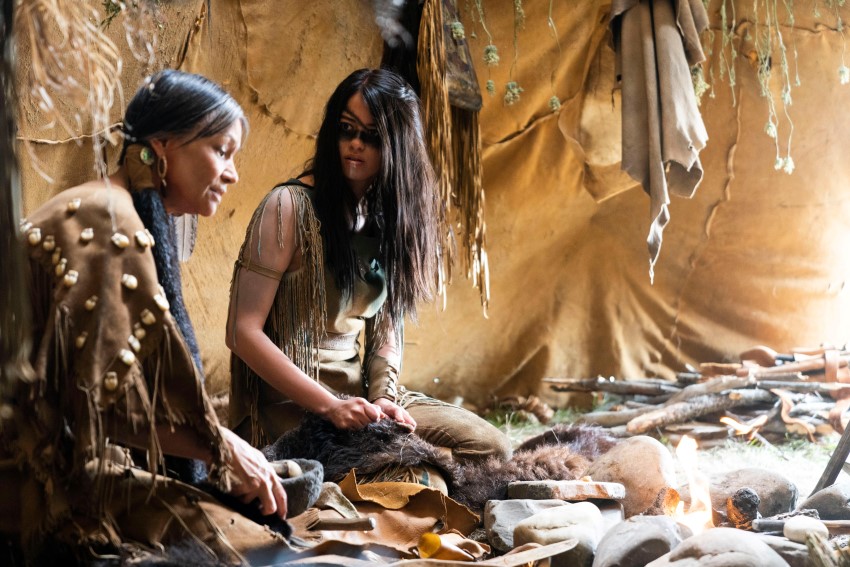
Was that challenging for you as an editor to cut walla and dialogue in Comanche, and to know whether it still made sense?
JS: It was a lot more involved, but I loved it. We would have Guy (the language specialist) and sometimes Jhane Myers (an exec. producer on the film) there to coach people through it. They would say the line themselves the way it’s supposed to be said, and then the actor would repeat it. So, Guy would say the line in English and say it in Comanche, and then the actor would say their line in Comanche.
Since we recorded Guy or Jhane on one track and recorded the ADR to a different track, I could always reference the English version.
It was cool because, by the end of it, I kind of felt like I knew some of the language. You’d be on stage speaking Comanche, and people would be like “what?”
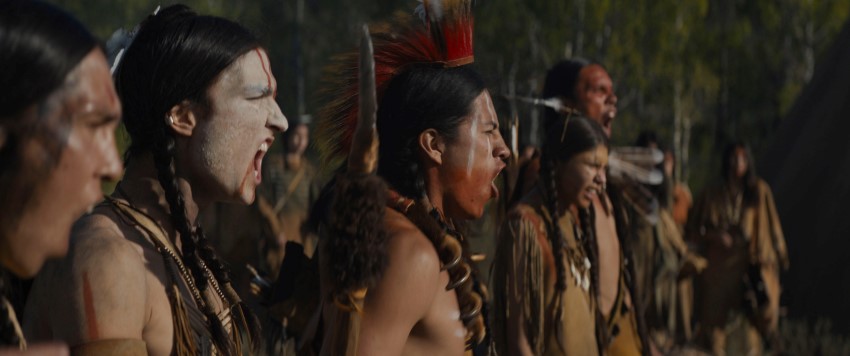
For some of the actors, like Taabe, there doesn’t seem to be a good place to put a lav mic. Were there lav tracks for all the actors? What were some challenges in working with the dialogue, especially for the action scenes?
JS: There was a lot of boom, and also a lot of plant mics. One of the jokes I was making is that I wished we could bring in each of the actors, play the movie and have them chase the whole thing just doing breaths and efforts because a lot of that is lost in the action sequences since it’s hard to get a mic in there. With everything else going on, you really want a clean, clear recording. Otherwise, if you boost that level it is just going to sound crappy.
For many of the fight scenes, we brought people in to record just breaths and efforts. Then Craig really mixed it in well; you could hear all the crazy action and the Predator screams, but you could also still get the humanity from the characters, from their breaths and efforts that they recorded. That balance turned out really nice.
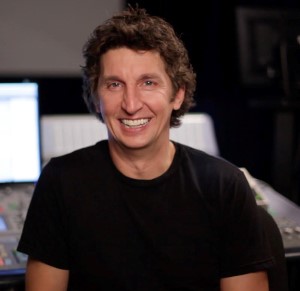
Craig Henighan (CH): Will Files, who is co-supervisor with Chris on the project, asked me, “Hey, can you mix the new Predator film?” That’s how the call went.
The awesome and fun thing about this one was we actually had Chris saddle up to the console and mix his own effects. It was one of his first mixes where he got to carry the sound design from the beginning all the way through, and then sit at the console and figure out how to mix it and make it work with the music and dialogue.
That was awesome and super fun for me because normally I’m an effects mixer. It was fun for me to work with dialogue and music – a little change of scenery!
That whole opening sequence was really a touchstone for how we were going to approach the overall soundscape.
Everyone spoke earlier about being really specific about sounds and very purposeful about why a bird is here or why something is happening sonically. In my role, starting Day One of the mix, it was about harnessing that idea as well. When you look at a film like this, you’re presented with the tracks that Chris and Jessie cut, and a fantastic score by Sarah Schachner. We started mixing the opening scenes, being really purposeful with the sounds, figuring out where to swell the music, and where to pull back. That whole opening sequence was really a touchstone for how we were going to approach the overall soundscape.
The journey of exploring these different facets of storytelling with sound was something that we did all the way through…
We had this approach of trying not to suffer too many details during the first pass. We really wanted to get the whole film up on its legs, to see what was working and what wasn’t working. We wanted Dan to have a lot of time to process how the scenes could sonically unfold. It was really collaborative on the stage and Dan really got into it. “What if we did this? What if we took this sound out?”
It was a lot of experimenting – some of it was very fruitful, just figuring out how to get the most from the emotional aspect of the film. The journey of exploring these different facets of storytelling with sound was something that we did all the way through – from the beginning right to the end. I can’t compliment enough what Chris and Jessie brought to the table – like the Comanche dialogue and the detail in the sound design.
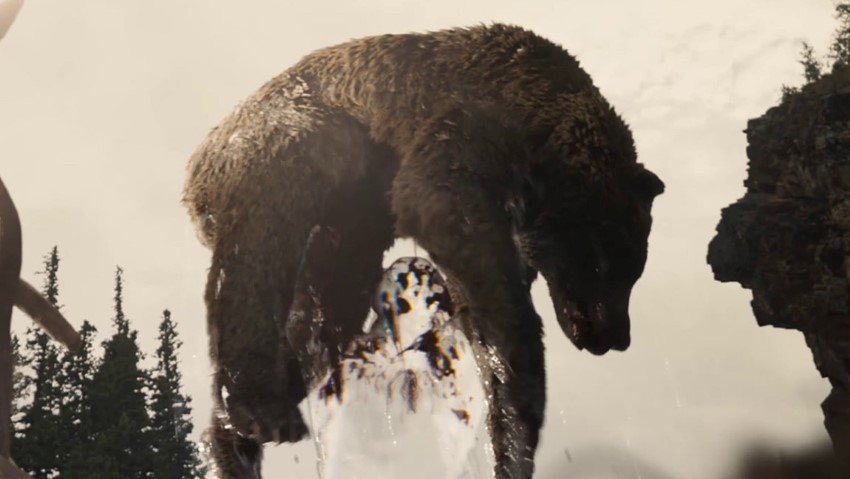
Setting up this road map for the mix in the first reel (in the first few scenes, actually), how did that help you when it came to more chaotic scenes, like the bear encounter later on in the film? Did it make it easier to weed the garden, as it were?
CT: Bears, in general, are hard due to the lack of variety of sounds they make. It’s a bit more repetitive. There are definitely a lot of bear sounds in there, but we had to weave it in and out of other sounds, like walruses or elephants that had that bearish type of vibe, especially because this bear in the film does a roar that is super long a few times and we wanted to get more variety in it.
…we had to weave it in and out of other sounds, like walruses or elephants that had that bearish type of vibe…
As far as the mixing goes, the hardest part was before we got Sarah’s score for that scene. The bear always had this big, percussive running sound but once Sarah’s music was in there, we figured out pretty quickly that there was competition between the bear running and the percussion of the music. That happened a few times in the film.
It was about finding that balance of frequencies and volume and panning (i.e., mixing). Getting it to a spot where they complement each other was probably the biggest challenge with sequences like that, especially when you want to feel the weight of a bear chasing you.
That scene was really fun because there were a lot of dynamics as far as what we got to do in the mix. We got to go underwater really quick, and in Atmos, we feel the bear dive above us. It gets really quiet for a second and we feel safe in the beaver dam and all of a sudden the bear is on top of us.
…we figured out pretty quickly that there was competition between the bear running and the percussion of the music.
That was another really fun Atmos moment where we got to make it feel like the bear is over our head and swiping down on us. For that scene, in particular, we probably did the most iterations because it was such an evolution of how it changed from where it started to where it ended.
But it was a lot of fun to cut; it’s a giant bear fighting Predator!
JS: I remember on stage, Dan would say, “More walrus!”
CT: He found out that the champion roar that the bear does after it thinks it killed the Predator was a walrus. So every time he’d do his notes, he’d ask for more walrus.
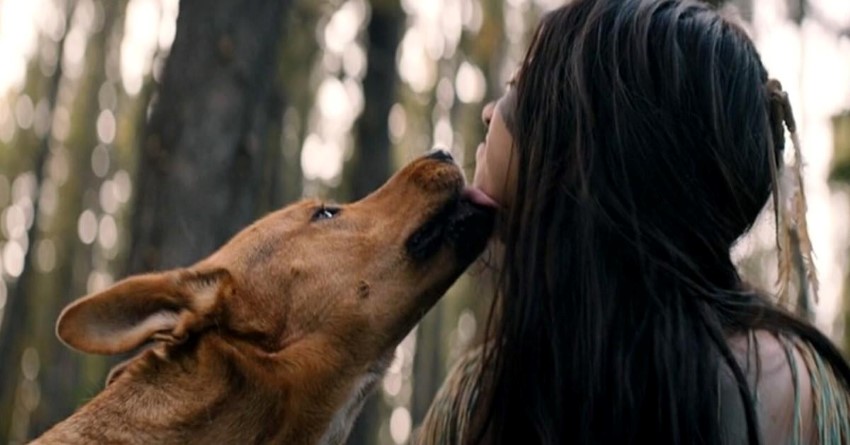
This may sound silly, but I liked the dog in that scene. It runs off far right and we hear it recede and then it comes back and runs far left. The sound follows the dog perfectly…
CT: It was important to feel like it wasn’t just a dog in the movie. Instead, it had to feel like an extension of Naru, like one of her utilities. It gives her the hint of danger or it comes in and saves her at the right time. I always wanted to make sure that dog felt like it was part of her character.
Dogs tend to be hard to cut too, especially if you want to get detailed. They’re always moving their mouths and it’s the little, mouthy tongue sounds that you have to cut in. But once it’s all there, it’s pretty satisfying.
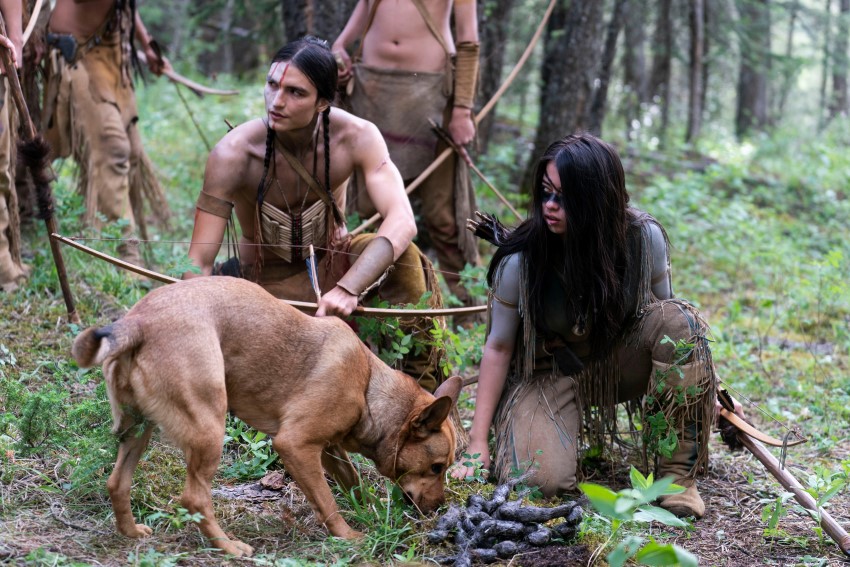
Did they put a lav on the dog to get all of its sounds?
JS: You could hear that dog in every recording. There was a lot of panting that I had to take out of the dialogue.
CT: Apparently, that dog was hard to work with. It wasn’t a SAG dog. They needed that dog because of the era. That was the right dog for that time.
You can’t tell in the final film; it looks like a well-trained dog. But behind the scenes, I hear it was a bit of a thing.
JS: In cutting dialogue, I have to listen to a lot of the outtakes and there was a lot of patience from the crew and the actors while they were trying to get the dog to do what they wanted. It was pretty amazing.
By the way, the dog’s name is Sarii, and sarii is the Comanche word for “dog.” So Naru’s dog’s name is “dog.”
[tweet_box]Behind the Gripping Sound of ‘Prey’ – with Chris Terhune, Jessie Anne Spence, and Craig Henighan[/tweet_box]
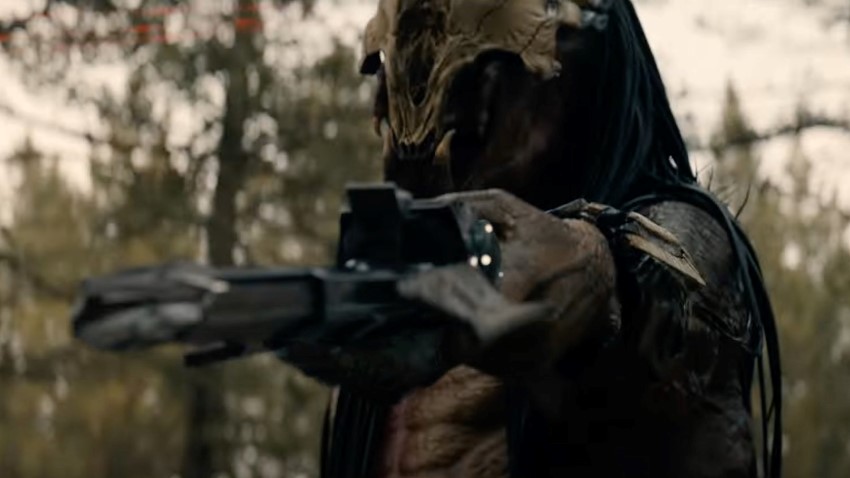
Let’s talk about the Predator attack on the French trappers. This is a really long sequence and we get to see some of the Predator’s cool tech and weapons. What were some of your sonic opportunities and challenges for designing and mixing this sequence?
CT: That was a moment we got to really open it up and just go for it with the gore and death.
It’s funny to watch the scene with an audience and hear them react to someone getting killed – like when the Predator throws a bear trap and snaps someone’s head off. The audience went wild. It’s really funny how people react to gore.
We cut that pretty early on before there were visual effects. That was a challenge itself because Dan would tell us where things were and we had to guess. But once the visual effects came in, it all started making sense and it all really came together.
The music made it a bit more lighthearted in the beginning, so the audience could really get behind him for that.
The music really affected how the scene played. There’s a jig in the beginning and then it went into the Predator’s theme, and then into slow motion. It just had a nice dynamic in the range of how it played. It was super fun and had a lot of comedic timing that really works in its favor as well.
JS: The jig communicated to the audience that this was the Predator’s time to play. All of a sudden, the Predator is like, “All right, here we go!”
The music made it a bit more lighthearted in the beginning, so the audience could really get behind him for that.
CT: And then when the scores shifted to that more intense music, it really amps you up.
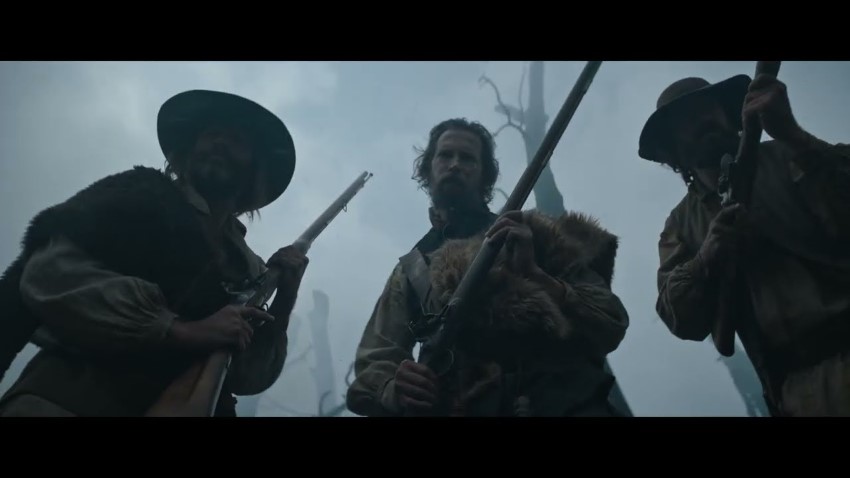
There was a great moment in there when the Predator throws those proximity mines, and they float up toward the French trappers and start beeping rapidly before they explode…
CT: That was always changing due to VFX but we finally found it. It always felt a bit over complicated but we decided that it just needed to be a cool series of explosions.
Dan and I are huge Star Wars fans so there’s a bit of a nod to Jango Fett’s Seismic Charges from Episode II. And he got super geeked when I played him that version so that was super cool.
Dan and I are huge ‘Star Wars’ fans so there’s a bit of a nod to Jango Fett’s Seismic Charges from ‘Episode II.’
Also, one of my favorite Star Wars sounds is when Vader’s helmet is sealed for the first time at the end of Episode III. There’s this beautiful depressurizing sound that always made me smile, so I channeled that when Predator put his bio mask back on his face during the Taabe battle; I got to scratch that itch, haha.
JS: There’s a moment when they hear the beeping and they all circle around, but “Big Beard” – the head French trapper guy – slowly backs away because he realizes before anyone else that what’s going to happen is not good. The actor that came in, Mike, was a blast to work with. He said that was his “Homer disappearing into the bushes” moment.
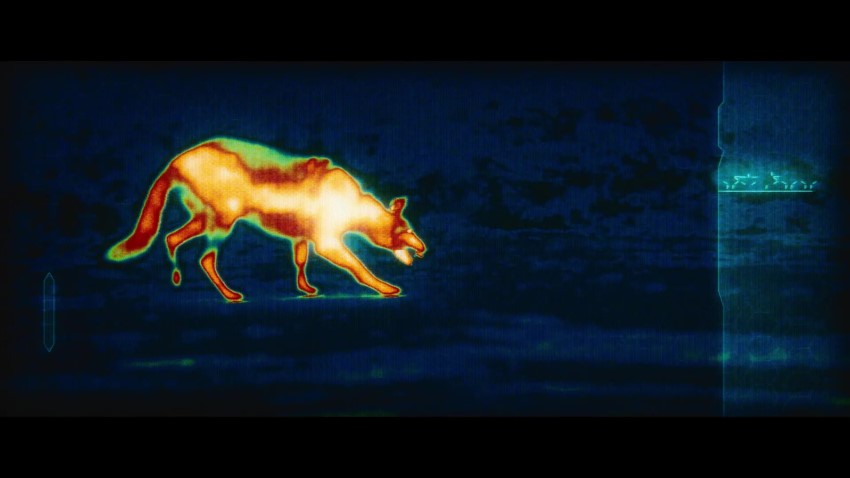
What about the “Predator-vision?” Was that a legacy sound?
CT: There are for sure the legacy sounds, like the hard WHIP in and the low-end heartbeat throb. We wanted to make sure those stayed in focus because you CAN’T change that; it’s too perfect.
However, we did sweeten those sounds with the support of new low-end and similar sounding stuff to help the fidelity side of it because those sounds can stick out sometimes as feeling “dated.”
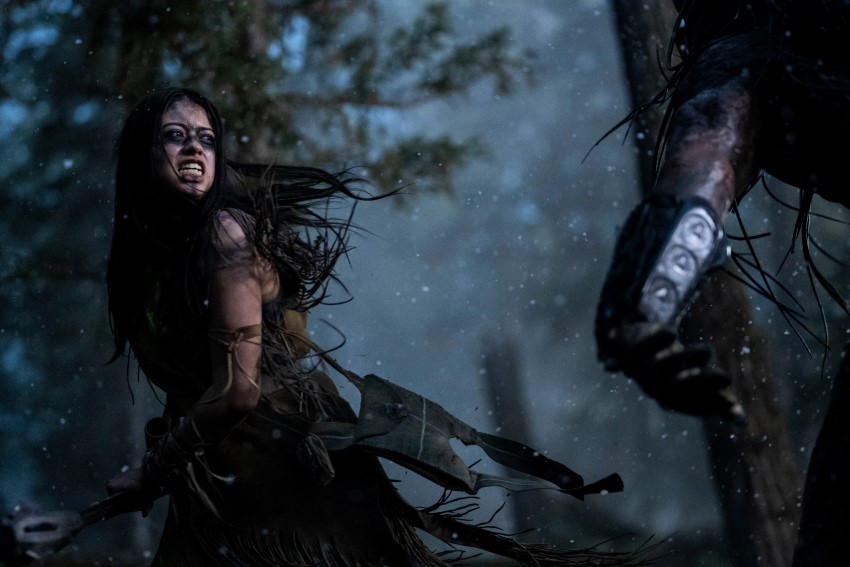
Let’s talk about another big scene when Naru takes on the Predator. Again, it’s a really long, action-packed, and fun sequence. What were some of your sonic opportunities and challenges for designing and mixing that scene?
CT: Overall, we were just keeping clarity in every choice of every sound – for every woosh, hit, impact, body fall, scream, and so on.
If you look at that session, one sound hands off to another. There isn’t a ton of stuff playing on top of each other, just because music and sound were so big and present that we needed to make sure they didn’t get in the way of each other. I think we really accomplished that.
…music and sound were so big and present that we needed to make sure they didn’t get in the way of each other.
It took a little time to get there, but that, to me, was the biggest challenge for doing passes – making sure that everything is carved out, that everything had its place, that the music was clear, and that the dialogue was clear. Overall, I think clarity was the biggest challenge for me.
CH: While Chris was going through his sound design and looking for things to take out, I was doing a similar thing to the score. Dan really zeroed in on some rhythmic pulses that Sarah had composed and they were really effective in other areas of the film. So when we got to this scene, it was about finding what we needed to tell the story. We spent a bit of time identifying musical elements that helped get us the right feel and then we started putting it together with Chris’s sounds and figuring out the handoff moments.
We decided on where the emotional moments were, and where the action moments were. What were the moments where it was just sound effects or just music?
…when we got to this scene, it was about finding what we needed to tell the story.
It’s one of those sequences where you want to get it working. You want to get the framework and then you want to step away from it and go work on something else for a little bit, and then come back the next morning and listen with fresh ears. It took a little bit of back and forth.
I can’t say enough about Dan’s ability to understand that when we’re mixing a loud sequence that’s quite long and has a lot of different aspects to it that we should go off and do something else for a little bit. He’s very smart and knows when we have it working we should leave it alone for a bit. Ear fatigue sets in and your ability to focus and understand the bigger picture starts diminishing after a while.
Ear fatigue sets in and your ability to focus and understand the bigger picture starts diminishing after a while.
We had the time to break everything down and experiment with all the elements and figure out how to make it the best we could to support the story – make it emotional and make it powerful.
JS: I was really impressed on stage with you guys. Not being a mixer myself, I don’t really know the process that well, but I would just watch Craig and Dan go back and forth. Dan would say, “Okay, take those drums out or take the strings out.” And all of a sudden, something would click. It might have been paring it down to just the drums or just the strings. And it was amazing how everyone in the room would just be like, “Yes, that’s it. You got it.”
It would add so much to just pare it back like that.
CH: That’s really a credit to Dan. We did that in the first sequence, in the first idea. I mocked something up, an approach I thought we should try, and then Dan came in and really got into it.
…you have to be brave enough to pull it all down, tear it all down to build it back up.
When you’re in the middle of it and you’re working on sequences and you’re like, “I don’t know if this is going to work.” Or, “This sounds really cool on its own, but how’s it going to connect to the scenes on either side of it? How are we going to get in and out of things?” You just start painting with sound a little bit and you have to be brave enough to pull it all down, tear it all down to build it back up. Dan was really into that for this film, and we could all see the benefits of it. You could hear right away that this process was going to work.
Everybody got on board, like Daniel DiPrima and Stephen Perone, our music editors. They were an immense help in identifying certain instruments – instruments that Dan liked, instruments that Sarah really liked, and then finding that balance.
CT: One thing that really helped me was Craig’s guidance. If I was ever in a spot where I didn’t know where an idea or a scene was going, he would say, “Break it, dude. Just break it.” Then we would just take it as far as we can and see what came out of that. That started to be my process, thinking “What can I get out of this?” Once you start to feel that you took it too far, then you can start to unwind it and land in a spot where you’re like, “This is it.” So you got to, as Dan would say, “Juice it up! Juice it up!”
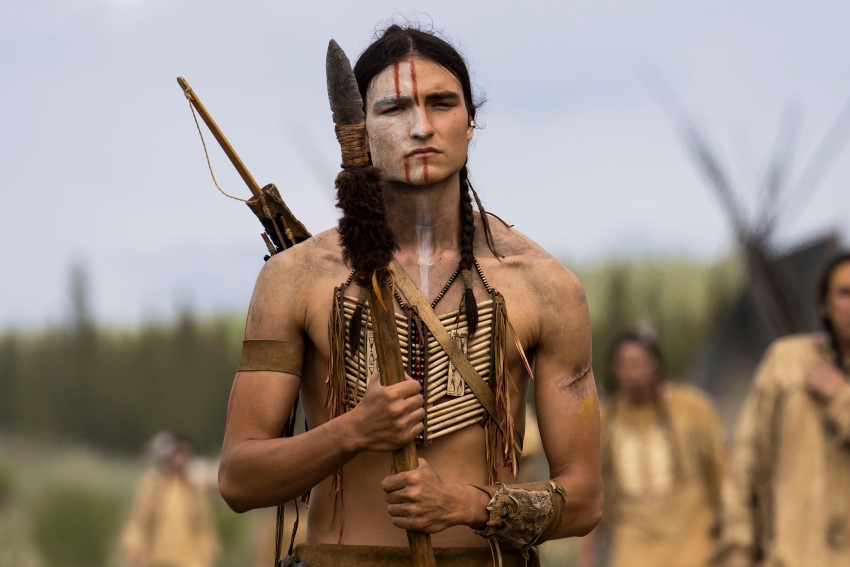
What about that subjective scene after Tabba dies? Was that always going to be a music moment? Or, was that something you found on the stage?
CH: Dan probably had it in his head that he wanted it to be subjective; that comes through in the images and how they’re cut together. For us, it was an instinctual thing. You get to a moment like that and know that you can’t just put all the sounds in and all the music in and think that it’s going to work. So we might have done seven or eight iterations of that idea on stage.
…you can’t just put all the sounds in and all the music in and think that it’s going to work.
We tried a version that was completely silent when the camera comes down to Naru washing the blood off her hands in the river. We tried a version that was just music. And then we tried a version that had water in it but Chris rolled off all the top end, so it was just the rumble. We tried a bunch of different variations of that.
Music-wise it took a little bit of time to find the right balance. Sarah’s score through that scene is absolutely beautiful. But the idea we hit upon (middle to late in the process) was to keep it really small when the score first comes in. It starts mono and then slowly opens up as we’re with their mom. When the news comes that her son’s gone, we slowly open up the sound field.
The idea of being small and somewhat muted and then opening up helps the audience go on an emotional journey.
CT: That’s one of those instances where we broke it. It was full of sound before we knew it wanted to be that. In our early temps, we tried a very small version of that before we had the music – before they understood what they wanted to do and they would extend the shots to complement it.
Always, the idea was to use the ring out of the Predator’s staff to tail out into that emotional state.
So after Taabe dies, the Predator looks around for Naru but she’s gone. So he pulls his staff out of Taabe’s body. Always, the idea was to use the ring out of the Predator’s staff to tail out into that emotional state. But we played it a bit more real, just mixed down and more ethereal sounding. That was always the idea.
But that whole scene where the Predator rises up behind Taabe, stabs him and lifts him up, roars, challenges Naru, and then it goes into the POV of Predator-vision was played like a regular scene. It wasn’t until the mix that we decided to start working it further back, to take that idea and start it sooner. So we ended up starting it on the stab.
You get a hint of the Predator-vision POV but the vacuum starts pretty early on in that scene.
So the only sounds we really hear are from Predator, like his victory roar and some of his growls. You get a hint of the Predator-vision POV but the vacuum starts pretty early on in that scene. And we carried very minimal sound for a long time. As Craig said earlier, for a director to lean in on that idea, it takes some intuition of where we want to go with this.
Usually, if you sit with silence in a movie, it’s not for that long. So to be able to do this for a long time shows how much he wants to pull emotion from scenes. He really wanted to sit with the loss of Taabe. This is a big deal. So it was really cool to go through that process with Dan and discover what that sequence wanted to be.
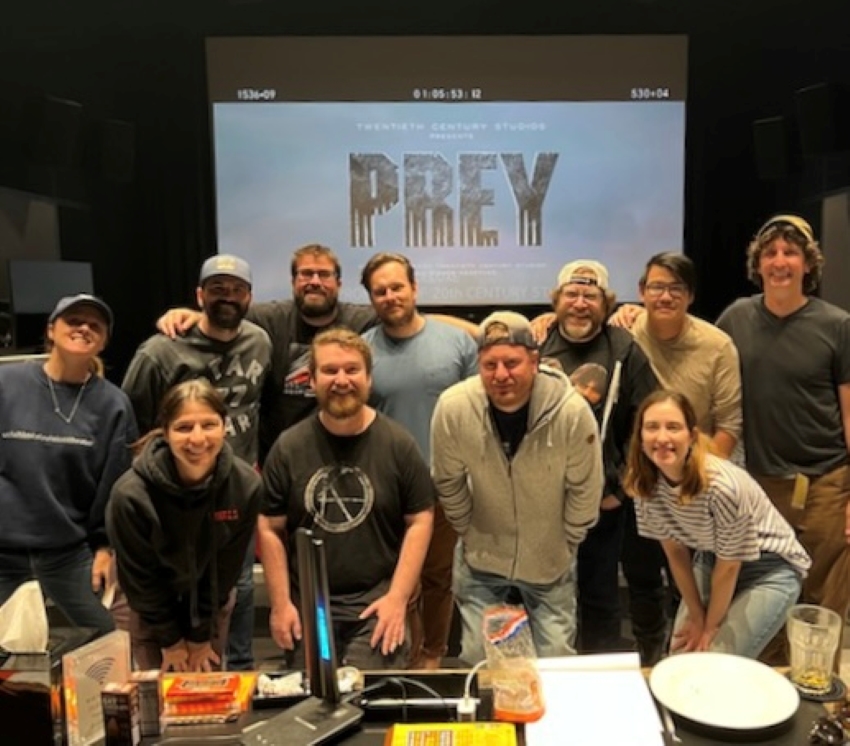
How was working on Prey a unique experience for you?
JS: For me, I was blown away by everyone’s dedication to and enthusiasm for the language and culture. It was fantastic. Every detail was paid attention to, and I learned a lot about the Comanche lifestyle and culture.
I was blown away by everyone’s dedication to and enthusiasm for the language and culture.
When I was doing some of the ADR with Jhane Myers and Guy Narcomi, they would point out things in the film that I wouldn’t realize – Comanche Easter eggs, I guess you could say. For example, there’s one part where Naru whistles to bring the Predator out to kill the French guy. Apparently, in the Comanche culture, you are not supposed to whistle after dark because it summons demons. So when they were filming that scene, Amber Midthunder (who played Naru) wouldn’t do the whistle because it was after dark and that’s not something that they do. So, I ended up recording my own whistle, and then Chris did some craziness to it and it ended up sounding really cool.
CT: I layered your whistle with a death whistle. So, your whistle started off at a high pitch, and then it hands off to the death whistle which sounds like blood-curdling screams. It worked really well.
…I ended up recording my own whistle, and then Chris did some craziness to it…
JS: It was creepy. But, there are things like that that the average viewer probably missed. It’s cool that they did a deep dive into Comanche culture. Being so involved with the Comanche language was fascinating to me. I’ve never dealt with a movie like that before, where you’re so immersed in a culture.
Also, the fact that Dan decided not to use subtitles at all is just the classiest move, I feel. Dan’s dedication to this film was amazing.
CT: Predator is one of those franchises that is known for its iconic sounds, especially the clicks. So I think for people like us, it’s such a candy store experience of sound.
Also, it was getting to work with your friends and filmmakers who really let you explore and dive in. Getting to live in this world was really special for me. And getting to mix with Craig was huge. Prey gave us that experience and I’m super grateful for it.
CH: Likewise on my end, for sure. Mixing dialogue and music isn’t something I do every day so it was fun to have this different overview and perspective of things.
It was the first time that Chris and I had worked together and that was a lot of fun, he did a fantastic job. I’m super proud of everyone who brought so much to the table. Special shout out to Joel Dougherty for a fantastic dialogue premix!
I just can’t say enough great things about Dan. It was always an evolutionary and exploratory journey. Those types of mixes are the ones that are the most fun and most satisfying to work on.
A big thanks to Chris Terhune, Jessie Anne Spence, and Craig Henighan for giving us a behind-the-scenes look at the sound of Prey and to Jennifer Walden for the interview!

